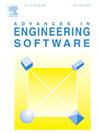Metaheuristic algorithms-optimized machine learning models for FRP-concrete interfacial bond strength prediction
IF 5.7
2区 工程技术
Q2 COMPUTER SCIENCE, INTERDISCIPLINARY APPLICATIONS
引用次数: 0
Abstract
Globally, the technique of reinforcing concrete structures with bonded fiber-reinforced polymers (FRP) has become widely adopted. The integrity of the interface between concrete and FRP significantly influences the behavior of the reinforced structure. Consequently, precise prediction of the bond strength at the concrete and FRP interface is crucial for the logical design and assessment of structures that are repaired and reinforced using FRP. This paper utilizes two emerging metaheuristic algorithms, the Slime Mould Algorithm (SMA) and the Dung Beetle Optimization Algorithm (DBO), to improve the performance of machine learning (ML) techniques, including KNN, SVR, GBDT, and XGBoost. Optimizing the ML models with metaheuristic algorithms significantly enhanced the prediction accuracy compared to the non-optimized models. The SMA-GBDT performed better than other ML models, achieving an R² of 0.9492, an MAE of 1.5294, an MSE of 6.4159, an RMSE of 2.5329, and a MAPE of 8.6916, based on the testing dataset. Specifically, the SMA-GBDT model exhibited improvements of 5.83%, 39.04%, 50.75%, 29.82%, and 43.84% in R², MAE, MSE, RMSE, and MAPE, respectively, compared to the non-optimized GBDT. The predictions made by the SMA-GBDT model were higher precision than those provided by the current design codes and existing models.
基于元启发式算法优化的frp -混凝土界面粘结强度预测机器学习模型
在全球范围内,结合纤维增强聚合物(FRP)加固混凝土结构的技术已被广泛采用。混凝土与FRP之间界面的完整性对加筋结构的性能有重要影响。因此,精确预测混凝土和FRP界面的粘结强度对于使用FRP修复和加固的结构的逻辑设计和评估至关重要。本文利用两种新兴的元启发式算法——黏菌算法(SMA)和屎壳郎优化算法(DBO)来提高机器学习(ML)技术的性能,包括KNN、SVR、GBDT和XGBoost。与未优化的模型相比,用元启发式算法优化ML模型显著提高了预测精度。基于测试数据,SMA-GBDT比其他ML模型表现更好,R²为0.9492,MAE为1.5294,MSE为6.4159,RMSE为2.5329,MAPE为8.6916。其中,与未优化的GBDT模型相比,SMA-GBDT模型在R²、MAE、MSE、RMSE和MAPE上分别提高了5.83%、39.04%、50.75%、29.82%和43.84%。SMA-GBDT模型的预测精度高于现行设计规范和现有模型的预测精度。
本文章由计算机程序翻译,如有差异,请以英文原文为准。
求助全文
约1分钟内获得全文
求助全文
来源期刊

Advances in Engineering Software
工程技术-计算机:跨学科应用
CiteScore
7.70
自引率
4.20%
发文量
169
审稿时长
37 days
期刊介绍:
The objective of this journal is to communicate recent and projected advances in computer-based engineering techniques. The fields covered include mechanical, aerospace, civil and environmental engineering, with an emphasis on research and development leading to practical problem-solving.
The scope of the journal includes:
• Innovative computational strategies and numerical algorithms for large-scale engineering problems
• Analysis and simulation techniques and systems
• Model and mesh generation
• Control of the accuracy, stability and efficiency of computational process
• Exploitation of new computing environments (eg distributed hetergeneous and collaborative computing)
• Advanced visualization techniques, virtual environments and prototyping
• Applications of AI, knowledge-based systems, computational intelligence, including fuzzy logic, neural networks and evolutionary computations
• Application of object-oriented technology to engineering problems
• Intelligent human computer interfaces
• Design automation, multidisciplinary design and optimization
• CAD, CAE and integrated process and product development systems
• Quality and reliability.
 求助内容:
求助内容: 应助结果提醒方式:
应助结果提醒方式:


